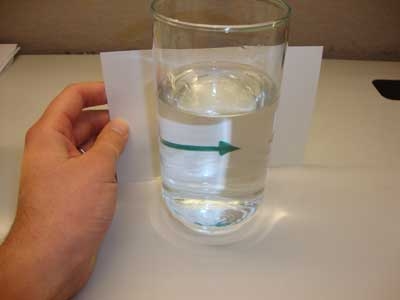
What you need:
A glass, water, paper, sketch pen, a table, a friend
What to do:
1. On the paper, draw two arrows parallel to each other. Make sure the arrows are pointing in the same direction.
2. Now, fill the glass with water and place it on the table.
3. Ask your friend to slowly lower the paper behind the glass so that the second arrow is covered by the glass.
4. You can stand in front of the glass and look through it at the arrow.
What happens?
The direction of the arrow behind the glass is reversed!
Why?
This happens because of a special property of light known as refraction’. Refraction is nothing but the bending of light as it travels from one medium to another. This is different from ‘reflection’ where light simply bounces back when it hits an obstacle.
Refraction occurs because the molecules of a medium are usually packed closer together than the molecules of plain old air. So the light is unable to stick to a straight path when it enters water or glass or anything denser than air.
When you look at the arrow behind the glass, the light from the arrow first passes from the air to the glass and into the water.
That means it has already bent twice (Air-Glass – Water). Then it comes back out the front of the glass to the air. That’s two more bends which are exactly the opposite of the first two (Water – Glass-Air). This opposing refraction is what makes the arrow appear flipped when the light finally makes it to your eyes!
Picture Credit : Google




